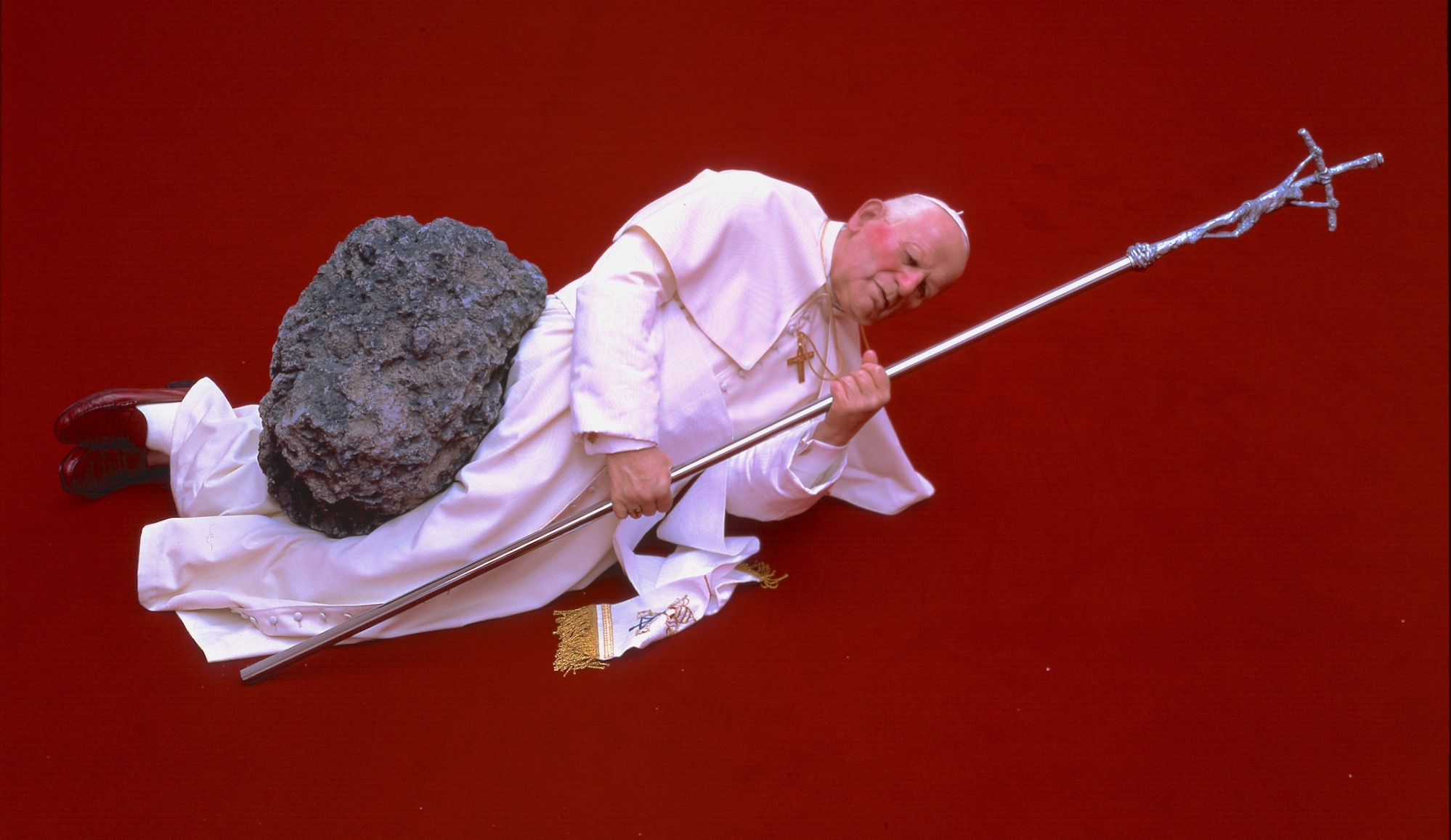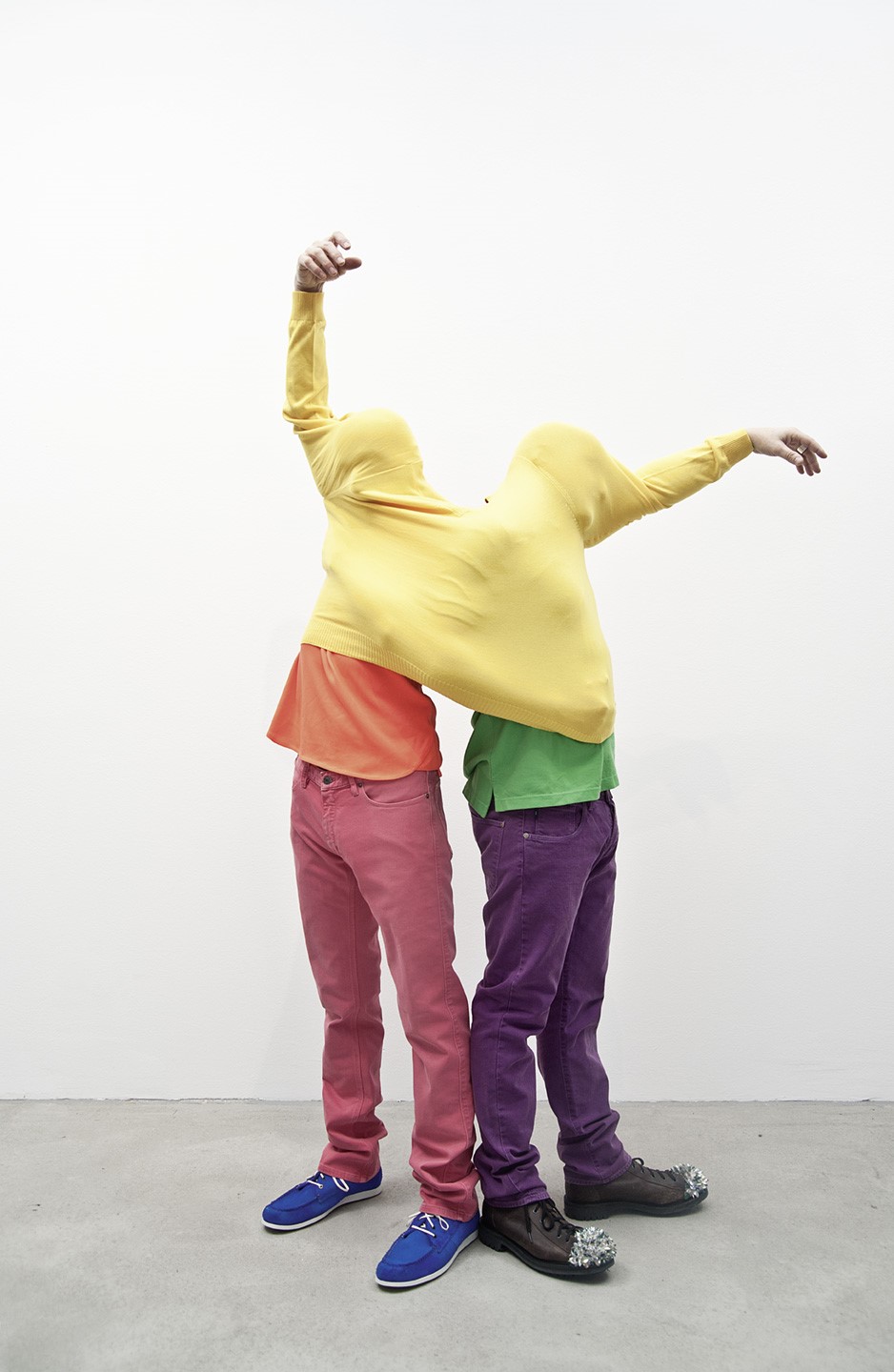by Joshua Glass
[On 16 January 2021, I published a post on Rick On Theater called “Hyperreal Theater,” which I noted was “little known, and had a short life in the 1980s and then largely passed from the scene.” I went on to explain:
The concept of hyperreal theater is based on that of hyperreal art, so I should explain the genre in visual art first. Hyperreal paintings and sculptures are so meticulously rendered that they resemble high-resolution photographs. In fact, Hyperrealism in painting and drawing is often equated with Photorealism.
[Quoting further from my introduction to “Hyperreal Theater”:
‘Hyperrealism’ is made up of the word ‘realism’ and the Greek prefix ‘hyper-,’ which means ‘over,’ ‘above,’ or ‘beyond. . . .
Hyperrealism is an art form that creates illusions by enhancing reality. Hyperreal artists in the medium in which they create place added focus in their work on the visual, social, and cultural details of everyday life.
[Joshua Glass’s “It Looks Like Us” appeared in the New York Times’ T: The New York Times Style Magazine of 22 October 2023. It’s a look at Hyperrealistic sculpture in the age of AI and deepfakes.]
The new eeriness of hyperrealist art.
This past summer [9 June-22 July 2023], a naked man was suspended from the wall of Galerie Georges-Philippe & Nathalie Vallois in Paris, his arms spread-eagle, resembling something between a crucified person and a cadaver. Onlookers couldn’t help but wince. One aghast couple seemed to turn their heads away. But like the dangling body, they, too, were unclothed sculptures — lifeless yet eerily lifelike.
The work was from “Grace,” an exhibition by the American sculptor John DeAndrea [b. 1941], who at 81 has been making human doppelgangers like these in a studio near the Rocky Mountains for almost six decades. His monthslong process involves first putting live models in silicone rubber molds, which are cured and then built up with layers of plaster. This negative mold is then filled with fortified plaster, which is cured, perfected and eventually recast in bronze. Finally, DeAndrea meticulously applies layers of opaque and transparent oil paints to the skin and eyes and adds hair until everything looks creepily authentic.
Art critics have come up with various terms for work like DeAndrea’s, including hyperrealism, although DeAndrea notably has said he doesn’t consider himself an artist. Perhaps a better name for it comes from Sigmund Freud [1856-1939]. In response to a 1906 essay by the German psychiatrist Ernst Jentsch [1867-1919], who wrote of the discomfort that arises when the viewer “doubts whether an apparently animate being is really alive; or conversely, whether a lifeless object might not be in fact animate,” Freud expanded on the concept of the uncanny. It’s the place where art and life converge and briefly become muddled, in a way that’s confusing and uncomfortable.
Why do artists keep returning to the uncanny, which Freud placed into “that class of the frightening which leads back to what is known of old and long familiar”? The hyperreal would seem to represent a very modem state of uncertainty: What is that thing? How can it look both recognizable and foreign at the same time? It’s an aesthetic that tends to return at particularly unstable moments in history. Freud wrote about the uncanny in 1919, months after the end of World War I, which had left millions dead and Europe in ruins. DeAndrea — who says his work “ain’t dark” to him — in the mid-1960s began experimenting with casting techniques that would allow him to accurately represent the human body, though he was probably less concerned with the Vietnam War than with the narcissism of what the author Tom Wolfe [American author and journalist; 1930-2018] would later describe as the Me Generation. Other hyperrealists, most notably DeAndrea’s contemporary Duane Hanson [American sculptor; 1925-96], were more overtly political. Hanson didn’t shy away from the war in Vietnam or American racism — his 1969 “Vietnam Scene” depicts dead and wounded U.S. soldiers lying on the floor — though he’s best remembered for his fiberglass-and-polyester-resin sculptures of tourists in southern Florida.
[In his essay “Das Unheimliche” (“The Uncanny”), Freud tackles the horrific concepts of inanimate figures coming to life. It was first published in 1919 (vol. V, iss. 5/6) in the journal Imago: Zeitschrift für Anwendung der Psychoanalyse auf die Geisteswissenschaften (“Imago: journal for the application of psychoanalysis to the humanities”), edited by Sigmund Freud and published quarterly in Vienna and Leipzig from 1912 to 1937. Wikipedia defines the subject thus:
The uncanny is the psychological experience of an event or individual as not simply mysterious, but frightening in a way that feels oddly familiar. This phenomenon is used to describe incidents where a familiar thing or event is encountered in an unsettling, eerie, or taboo context.
[There are many translations of “The Uncanny” into English available.
[Tom Wolfe’s essay, “The ‘Me’ Decade and the Third Great Awakening,” ran in New York magazine on 23 August 1976. He didn’t actually use the phrase “the ‘Me’ Generation,” but his coining of the term “the ‘Me’ Decade,” which referred to the 1970s, gave rise to the label for the Baby Boomer generation. Born immediately after World War II, this population bubble started to come of age in the ’70s and Wolfe saw them as the epitome of self-absorption, narcissism, and self-indulgence.]
Each subsequent decade has gotten the hyperrealist sculpture it deserves. Right now we’re living in a moment defined by an erosion of trust in what is and isn’t real — whether that’s a former president’s election fraud claims or the proliferation of deepfakes and artificial intelligence software. The uncanny valley has transformed from a horror film trope — in movies from Ridley Scott’s “Alien” (1979) to John Carpenter’s “The Thing” (1982) to the unsettlingly human robot in [Gerard Johnstone’s] “M3gan” (2023) — into a more quotidian concern, as Elon Musk and Jeff Bezos propose a fleet of humanoid robots to address the U.S. labor shortage. It’s possible that hyperrealist art has never felt as topical, or as chilling, as it does today, and advancements in technology have also rendered the style more real than it’s ever been.
Over time, hyperrealism incorporated elements of extreme exaggeration, which only seemed to heighten the shock of the uncanny. That effect is palpable in, for instance, the Australian artist Ron Mueck’s [b. 1958] gargantuan child made of glass fiber, “Boy” (1999): Installed in the ARoS museum [Aarhus Kunstmuseum (Aarhus art museum)] in Aarhus, Denmark, the child is nearly 15 feet tall, even crouched in an almost fetal position, and all his details are rendered with excruciating precision.
The Italian artist Maurizio Cattelan [b. 1960], a master of discomfort, has contributed to the hyperrealist tradition for more than 20 years. His funny and disturbing “La Nona Ora” (1999) shows Pope John Paul II in his papal regalia, writhing in pain on the ground after being struck down by a small meteor. The pope retains an odd dignity, still clutching a staff with a crucifix on it, as if that might help him through this encounter. Two years later, Cattelan made “Him,” a dreadfully realistic sculpture of Adolf Hitler, kneeling like an altar boy, hands clasped as if in prayer. As in the work centering the pope, it’s the absurdity of the contrast — between evil and innocence — that’s so effective and obscene. “It is a fake until proven otherwise,” explained Cattelan of his installations of this nature.
Many works of hyperrealism call on old traditions of mimesis, among them anatomical wax models based on real carcasses, a technique dating to the 18th century. Lately, though, new technology has made hyperrealism easier for humans to achieve, while simultaneously complicating the practice. The Australian visual artist Patricia Piccinini [b. 1965], 57, has been making anthropomorphic chimeras out of silicone, fiberglass, leather and human hair for the past two decades: a grotesque porcine creature, its brood suckling at its teats (2002’s “The Young Family”); a bearlike man who could pass for a shaved Bigfoot (2012’s “The Carrier”). Recently, however, she had a disconcerting encounter of her own when she came across images of artworks online that appeared to be attributed to her. “It had my name on it, but it wasn’t me,” the artist said. It was the product of an A.I. art generator — one that used randomized machine learning to mimic her reimaginations. “What I saw looked like it had been made by someone who had only been told about my work by someone who didn’t understand it,” she said.
It’s a worrying development for any artist, but also one that has made human-engineered hyperrealism even more relevant — us versus the machines. In 2011, the Austrian-born sculptor Erwin Wurm [b. 1954], 69, modified a red Mercedes-Benz MB100D van so that its rear half curved up the side of a wall. When it was installed four years later outside of the Center for Art and Media in Karlsruhe, Germany, a traffic warden gave it a parking ticket. Wurm says that we live in an age when our brains are constantly trying to make sense of what we see. “Is it nature or is it copying nature?” he asked. “You think it’s nature, but then you realize, ‘Wait a moment, it’s not. It’s something else.’”
With his series of “One Minute Sculptures,” begun in 1988, Wurm has taken hyperrealism to its inevitable extreme: He’s turned actual people into bizarre and improbable sculptures. He directs strangers to participate in seemingly impossible scenes — in which office supplies protrude out of orifices, or a forehead is attached to a leaning tower of oranges — instructing them to pose for 60 seconds or less as he photographs them.
“Reality is totally insane, we have to compete with it,” said Wurm. That, ultimately, is why such art matters: By jolting us out of our usual perspective, it makes us question what we may be overlooking every day. “I see the world going in a strange direction,” Wurm added, “and I’m scared for the future.”
[Who remembers the “Is it live, or is it Memorex?” ad slogan for the company’s audio cassettes in the 1970s and ’80s? Isn’t that what artist Erwin Wurm meant when he asked, “Is it nature or is it copying nature?”
[And Patricia Piccinini’s complaint that the imitations of her work made by artificial intelligence looked as if they “had been made by someone who had only been told about my work by someone who didn’t understand it” is very much like the anecdote about a blind person who’s asked to describe an elephant by touch. After the examination, the person states, “This is a large animal with two tails.”]






No comments:
Post a Comment